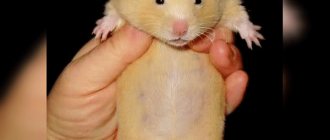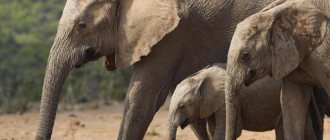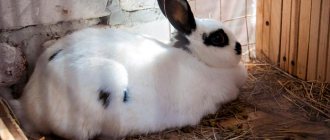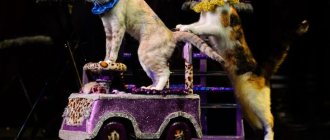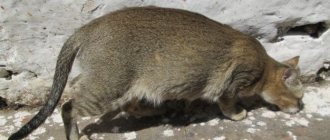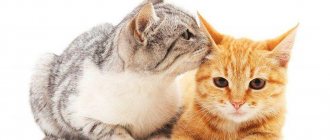Lat. Hippopotamus amphibius
Hippopotamus , or as it is otherwise called, hippopotamus, is one of the largest land mammals on earth.
| Order - Artiodactyls | Family – Hippos | Genus - Hippos |
| Habitat : Africa |
| Habitat : water |
| Length – 270 cm |
| Body weight – average – 1800, rarely up to 4500 kg |
| Reproduction method : viviparous |
| Number of cubs – 1, very rarely – 2 |
| Life expectancy – up to 40 years |
| Conservation status – vulnerable species |
What does a hippopotamus look like, physical characteristics
human size ratio
The height at the withers is about 150 centimeters, the body length is 270 cm. The body is rounded with disproportionately short legs. The thick purple-brown skin appears bare, with a small amount of stubble around the mouth and on the tail, but in fact the animal's body is covered with fine hairs all over its surface.
Mouth and teeth
A large head with a wide mouth, the huge mouth of the hippopotamus opens 180 degrees, it has 36 teeth: two incisors on each side, one canine, three premolars and three molars.
teeth
How much does a hippopotamus weigh?
An adult weighs about 1800 kg, newborn animals about 35 kg. Record holders and long-livers can gain up to 4500 kg.
Nutrition
In search of food, animals can move away from bodies of water up to 8 kilometers. You have to spend at least 4-5 hours on the pasture to support the gigantic weight of the hippopotamus. An adult hippopotamus is capable of consuming about 70 kg of vegetation per day. In rare cases, they may eat carrion, but this only happens in conditions of food shortage.
The width of the trenches through which animals make their way to the pastures is equal to its thickness. Hippos very jealously guard their territory, even dividing water spaces. The main male has a section of the coast reaching up to 250 meters in length. Up to 15 females live with him along with their cubs of the last year. Grown-up males form their own groups.
Where it lives, range and distribution
spreading
It lives in sub-Saharan Africa, but many populations are extremely small, especially in West Africa, where hippopotamuses are divided into isolated groups of several dozen individuals. Large populations are found in eastern and southern Africa, including Zambia, the Democratic Republic of Congo and Tanzania.
Lives in shallow fresh water: lakes, rivers, ponds, puddles. Any body of water in which the skin remains wet. Wet mud is also suitable. Hippopotamuses are often found in drying up ponds. At night they leave the water and graze in meadows, which can be one and a half kilometers or more from the lake.
Habitat
At the beginning of the last century, these animals were found throughout almost the entire territory of Africa: from the mouth of the Nile to Cape Town. Today, hippopotamuses are rarely seen in the eastern or central parts of the continent. However, even these encounters most often occur in national parks that protect this species of mammal.
During the daytime, animals sleep in the water. They begin searching for food when darkness comes. They return to the pond just before dawn. Each hippopotamus has a personal path along which it gets to the pasture. The weight of a hippopotamus, which averages 3 tons, is gained thanks to nutritious grass and aquatic plants.
Behavior
fight for territory
At the moment, the behavior is not as well studied as we would like, since this species is difficult to study. According to available data, it is characterized by pronounced gregarious behavior in the aquatic environment, but at night, when individuals come to the surface, they are prone to solitary behavior. Only the social connection between the female and the cubs is preserved.
Males divide the territory and fight for females in the water, protecting their borders. But this is not a harem system and females may not return to the territory of the same male every day. Males can allow young competitors into their territory if they behave submissively and do not show aggression. When a free male challenges the owner of the territory, a fierce battle ensues between them, with a likely fatal outcome for one of the duelists.
How to mark territory
They do not divide territory on land. They spray their feces over the territory, while energetically waving their tail to increase the range of spraying the droppings. The exact purpose of such actions is not clear. This is probably necessary to demonstrate a dominant position or for orientation by smell in the dark.
The roar of a hippopotamus is a known phenomenon, but the social function of this action is unknown. Animals also scream underwater, making various sounds, probably for communication. Some underwater signals travel through water and air simultaneously.
roar volume 110 dB
Interesting facts about hippos
- Hippos lead a sedentary lifestyle. To ensure that there is always enough vegetation on their site, animals fertilize the ground with their own droppings, scattering them with their intensively rotating tails. Excrement located on the soil surface also serves as markers to mark the herd's territory.
- One of the reasons for the decrease in the number of hippos is the hunting of these animals for meat. Hippopotamuses only seem fatty, but in fact their carcass consists entirely of pulp, which tastes very similar to young beef. Hippopotamus meat is not only tasty, but also very healthy: up to 25% of its composition is proteins.
- Despite its plant-based diet, the hippopotamus is dangerous to humans. More people die as a result of attacks by this huge mammal than from attacks by sharks, lions, leopards and other predators.
- The length of the stomach of an adult hippopotamus is 2.5-3 m, and the total length of the digestive tract is 60 m. The amount of food that can fit in it reaches 200 kg. The significant length of the gastrointestinal tract and the peculiarities of its structure allow the animal to maximally absorb fiber from plant foods.
- Hippos quite often show their emotions with a loud roar that can be heard from a distance of several kilometers. The sound intensity can exceed 100 dB. Several types of sounds are used to exchange information between relatives; hippos can scream and roar on land and in water.
- Hippos are able to open their mouths so that the angle formed between the jaws reaches 150 degrees.
Reproduction
Polygamous. Hippopotamuses mate in water. The gestation period lasts 240 days, which is a very short period for such a large animal. Before giving birth, the female leaves the herd, and the baby is born in the water. A newborn hippopotamus is usually born alone and weighs from 25 to 50 kilograms.
relationships within the team
Individuals living near the equator can give birth throughout the year, but there may be birth peaks associated with precipitation. The surges occur at the beginning of the rainy season. Away from the equator, where precipitation is less, seasonal fertility prevails.
Breastfeeding lasts about a year. The cub remains with the mother even if a second child is born, but leaves before puberty. Sexual maturity occurs at 7.5 years for males and at 9 years for females.
Origin
The name of the animal comes from two ancient Greek words: horse and river. It is not difficult to understand that it can be called a river horse. However, the hippopotamus has nothing in common with horses. As with the pigs with which they are often compared. Its closest relative, surprisingly, is the whale.
A long time ago, about 60 million years ago, the planet was inhabited by the ancestors of modern animals. At a certain point, some of them remained on land, while others sank into the water. This happened about 55 million years ago. Despite the fact that hippos chose land, life without water is unthinkable for them, and it is needed not only to quench their thirst.
Article on the topic: Interesting: nearby are deserts and semi-deserts of Russia
Hippopotamus and man
This is a dangerous animal. There have been many recorded cases of hippopotamus attacks on humans, which ended fatally. Fishermen are the ones who suffer most often. Hippos also often eat rice crops. In turn, man hunts this animal for its meat and bones. Local residents hunt with a harpoon. Many unsuccessful harpooners die while hunting. The animal often appears in African folklore.
dangerous jaw and fangs
Offspring
The health of the offspring depends on the quality of the female’s nutrition during pregnancy and the interval between matings. At birth, babies do not see or hear anything, they have no fur, but they have a good appetite. Each weighs no more than 1.5 g.
After a week, you can see grown hair on the animals’ bodies, and the first incisors of the lower jaw appear in the mouth. By 14 days of age, a baby mouse can already see and hear.
Females have noticeable nipples from childhood. In males, the testicles move from the abdominal cavity to the scrotum only in the second week. It is after this that the gender of the offspring can be understood.
A wild litter is not the same as that of a domestic mouse. It develops faster. If indoor rodents are picked up prematurely, the mother may abandon them.
Therefore, offspring can be accustomed to human attention after three weeks, when rodents leave the nest in search of new horizons.
Month-old indoor animals can be given to other people for new families. At this age, they are unlikely to eat their mother's milk. And they switch to adult food and become completely independent.
Video
The mouse has given birth! What to do ?
Popular questions about hippos
How is a hippopotamus different from a hippopotamus?
Nothing, these are equal names for the same species.
How does a hippopotamus swim?
Swims with the help of its hind limbs, in shallow water it pushes off the bottom with its front paws. Can dive for long periods of time. Capable of remaining underwater for half an hour.
in water
The largest hippo in the world
This is the common hippopotamus (Hippopotamus amphibius); the body weight of individual individuals can reach four and a half tons, which is very close to the weight of an elephant.
What color is a hippopotamus?
Gray-brown with a pinkish tint.
Why do they have pink milk?
In fact, it is white, but when mixed with sweat secretions it acquires a pinkish tint.
How long do they live?
The lifespan of individuals of this species ranges from 30 to 40 years.
Number of species
Today, the world population of hippopotamuses is about 100,000 animals.
Characteristics and description of the animal
Hippos are mammals that lead a herd lifestyle. Groups consist of one dominant mature male, several adult females and their young of different ages. The number of individuals in a herd usually ranges from 20-30 animals, although sometimes larger families numbering up to 150-200 animals are found.
For most of the day, hippos sleep in the water or in swamps in shallow water, and when evening comes, they leave the reservoirs and go in search of food. The herds do not move more than 1-1.5 km from the shores, and after grazing they return to their old place. Hippopotamuses are characterized by attachment to one area, which they do not leave throughout their lives.
The clumsy and heavy-looking animals are excellent swimmers, and on land they can briefly reach speeds of up to 35 km/h.
The need to hide from the scorching sun in the water is due to the special structure of the skin of the hippopotamus. Despite the fact that the thickness of the skin of adult animals reaches 3-4 cm, its surface is very sensitive to sunburn. Due to the absence of sweat and sebaceous glands, as well as the almost complete absence of fur, the skin of a hippopotamus instantly dries out and cracks. The secretion produced by the skin glands helps partially prevent the skin from drying out. Its consistency is somewhat reminiscent of mucus, and with prolonged exposure to ultraviolet radiation it acquires a reddish tint. Unlike zebras, whose milk is pink due to its composition, hippopotamus milk acquires a pink color when mucus from the skin glands enters it.
What does it look like
The appearance of the hippopotamus has the following features:
| Body | Massive, barrel-shaped, has the same thickness from head to tail |
| Head | Rectangular in shape, the muzzle is wide and blunt, the ears are rounded, small and very mobile, the eyes are small |
| Legs | Thick and short, hind and forelimbs are of equal length and end in 4 toes |
| Tail | Reaches a length of 40-50 cm, thick and round at the base, narrower and flattened at the sides towards the end |
| Leather | Smooth, covered with a small number of short hairs |
| Color | Gray or taupe, areas of skin near the ears and around the eyes have a noticeable pinkish tint |
The features of hippopotamus adaptation to their environment are:
- the upper location of the eyes and nostrils on the muzzle, allowing the animal to almost completely submerge under water;
- the presence of membranes between the fingers that speed up movement in a river or lake;
- the ability to close the ear canals, nostrils and mouth when immersed in water.
How many years do they live
In the wild, hippos usually live to be 40-45 years old. In captivity, their life expectancy increases by an average of 10-15 years.
The main causes of death for animals living in natural conditions are fatal injuries during fights for leadership in a group, shooting, and attacks by predators. Many adult males and females over the age of 30 die from starvation. This happens not due to lack of food, but due to the wear of the animal’s teeth. As the molars wear down, it becomes more and more difficult for the hippopotamus to chew the required amount of food. Gradually he weakens and dies.
How often do they breed?
With uncontrolled mating in comfortable conditions, a mouse can produce up to 14 offspring per year, which is an average of 70-140 rodents. In captivity, if the animals live in the same cage, then there is no obstacle to fertilization.
But breeders, knowing how often mice breed, should remember that the female must be protected and separated from the male. She needs enough time to recover, otherwise the offspring will be stunted and unviable.
The female is ready for mating within a day after giving birth. But since this is a big burden for the mother, it is better to mate no more than 4 times a year. Especially if the female feeds and raises the offspring herself.
In the wild, the process occurs uncontrollably and practically does not stop. The only obstacle to reproduction may be a decrease in temperature. But this does not apply to animals that have found a new home in a warm human home.
In this case, it is better to hurry up and call a disinfection service, otherwise a new colony of rodents will soon fill your home.
Elephant: 15-18 months
Elephants are the largest among animals living on land. A female's pregnancy lasts on average 15-18 months, but exceptions occur when gestation lasts up to 22 months. After birth, the newborn is under the care of members of the herd.
After gestation, the female gives birth to one elephant calf weighing from 90 to 115 kg. An individual aged 8-13 years is considered sexually mature.
Found a violation? Report content
Keith: 12-16 months
The largest living creature on the planet is the whale. It is also distinguished by one of the longest gestation periods - from 12 to 16 months. This period is not the same for all whale species and varies depending on the species. Among the species of the whale group, sperm whales have the longest gestation period, which is approximately 16 months. Next comes the narwhal toothed whale, whose female pregnancy lasts 14 months.
One baby whale is born per birth. The period of feeding and puberty depends on the type of whale and can last quite a long time.
For men over 50: a selection of spectacular haircuts to create an impressive look
“Fisherman’s” sandals and 4 more pairs of shoes without heels, in which your feet will not get tired
Serebryakov returned to Russia. Shukshina believes that he should not have left
How many months does a moose bear?
The moose bears
offspring up to 240 days, usually one calf is born.
Already on the third day of their life, babies are able to move independently. Since elk milk is very fatty, they feed exclusively on it until almost six months of age. Upon reaching two years of age, the elk
is considered sexually mature.
Interesting materials:
How often is initial training carried out? How often is a psychiatric evaluation performed? How often do flight attendants fly? How often is a cashier's report prepared? How often is the hepatitis B vaccine given? How often do technicians receive hygiene training? How often is the Remuneration Regulation approved? How often are dividends paid on Sberbank shares? How to apply for mat capital through government services? How to pay for kindergarten through mobile banking?
Pregnancy
Pregnancy and childbirth of a house mouse are practically no different from those in the wild. But the decorative offspring are significantly larger in size than their street relatives.
To get healthy animals, a pregnant mouse must receive proper nutrition; the female must not be picked up or moved around her cage.
10-12 days after conception, the female significantly gains weight and becomes rounder. Swollen nipples take on a bright pink color. The mother should be weighed every 3-4 days to monitor weight gain.
If weight loss is noticed, it is important to consult a veterinarian. In the absence of timely assistance, the pregnancy may be terminated. The main problem is often toxicosis. It can arise from poor nutrition, poor environment, or lack of fluid.
Brucellosis can also cause premature birth. Therefore, in such a situation, it is important to conduct a bacteriological study in order to begin treatment in a timely manner.
During the entire short period of pregnancy of mice, the mother manages to arrange a nest for her future offspring. At home, for this you need to provide her with paper, hay, and rags. Wild relatives easily find everything they need in the environment themselves.
After conception, the dose of food should be increased by a third, and starting from 10-12 days, doubled. To supply the body with vitamins, you can add calcium and glucose to the water. It is also useful to offer the animal carrots, grain, clover, and alfalfa.
Childbirth
You can find out how many mice give birth and the number of offspring from a veterinarian. On average, the entire period lasts no more than 2 hours. The most difficult thing is that the process often takes place at night, between midnight and 4 am.
Sometimes this time shifts to the period from 16 to 20 pm. At home, some males help mice give birth; they lick the babies and cover them. In the wild, the female remains on her own, as individuals disperse immediately after mating.
Usually the birth is successful, but in some cases veterinary care cannot be avoided. This may include the presence of contractions and the absence of babies for 15 minutes.
Sometimes the birth process stops after the appearance of the first animal and, if there are still cubs in the womb, they must be removed artificially.
A mouse can get stuck when giving birth to an old female or if the baby is too large. It is in these situations that you should immediately show the female to a doctor.
Pet mice should not be touched after birth, as the mother may abandon them or destroy the babies that have a foreign odor.
Term
Pregnancy of domestic and wild mice lasts about 17-23 days. The duration depends on the number of offspring. The more animals a female bears, the less time she needs to give birth.
Mice are very prolific animals and, if left unchecked, are capable of creating a colony of their own kind in a short period of time. In the case of wild animals, this is bad, since a horde of pests will quickly destroy all human food supplies.
It is harmful for ornamental species of mice to reproduce so often, since the mother’s fragile body is not able to produce healthy, strong offspring without proper temporary rest.
Therefore, in the case of street rodents, they must be quickly destroyed when even one animal is discovered, and the reproduction of domestic mice should be carefully controlled and limited to 2-4 matings per year.
Giraffe: 13-15 months
The tallest and one of the largest living animals on the planet is the giraffe. The gestation period of this animal’s offspring is no less exciting than the offspring themselves, since it can last from 13 to 15 months. After this period, one baby is born.
It is noteworthy that the female giraffe gives birth while standing. The newborn animal is up to 6 feet tall. Small giraffes, like the animals described above, can stand and run independently a few hours after birth. Giraffes reach sexual maturity at 4 years of age.
Apple does not leave the market in Russia, agreeing to install Russian software
“Start by finding yourself”: Tina Kandelaki gave advice to single women
Many lines and two branches: we read the marriage lines under the little finger
Camel: 13-15 months
Camels are known for their adaptability. This amazing animal, unlike others, deserves attention for another feature - pregnancy, which lasts 13-15 months. This period varies depending on the type of camel. There are two types of these animals in the world: Bactrians and dromedaries. The pregnancy of the first lasts 13 months, respectively, the second - 15 months.
A female camel gives birth to only one baby, but cases of twins are not excluded. The weight of a newborn camel can reach 40 kilograms. Within the first hour, the little camel gets up and begins to walk. Individuals are considered sexually mature at 3 years of age.
